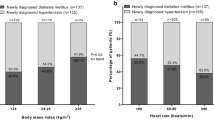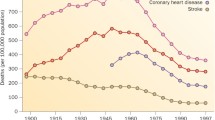Abstract
Interpretation of some recent trials in hypertension opened a debate on the clinical value of new-onset diabetes in treated hypertensive patients. It is not completely clear whether certain antihypertensive drug classes are associated with a higher risk for developing type 2 diabetes when compared with other classes. Some longitudinal studies suggest that new-onset diabetes in treated hypertensive subjects carries a risk for subsequent cardiovascular disease similar to that of previously known diabetes. In a study, plasma glucose before treatment and diuretic treatment were independent predictors of newonset diabetes in hypertensive patients, independent of confounding factors. We estimated that one cardiovascular event associated with new-onset diabetes might be prevented for every 385 to 449 patients treated with "new," rather than "old," antihypertensive drugs for approximately 4 years. These observations suggest that concern about the risk for newonset diabetes should prompt a more judicious use of diuretics and β-blockers in the treatment of hypertension. These drugs should be given cautiously in subjects who are at increased risk for new-onset diabetes, owing to impaired fasting glucose or obesity. The lowest effective dose should be used, and plasma glucose should be carefully monitored.
Similar content being viewed by others
References and Recommended Reading
Kannel WB, McGee DL: Diabetes and cardiovascular risk factors: the Framingham study. Circulation 1979, 59:8–13.
Chobanian AV, Bakris GL, Black HR, et al.: Seventh report of the Joint National Committee on Prevention, Detection, Evaluation, and Treatment of High Blood Pressure. Hypertension 2003, 42:1206–1252.
The ALLHAT Officers and Coordinators for the ALLHAT Collaborative Research Group: Major outcomes in high-risk hypertensive patients randomized to angiotensin-converting enzyme inhibitor or calcium channel blocker vs diuretic: The Antihypertensive and Lipid-Lowering Treatment to Prevent Heart Attack Trial (ALLHAT). JAMA 2002, 288:2981–2897. In this trial, a notable difference in new-onset diabetes was observed between the different therapeutic regimens. The incidence of new diabetes at the end of the study was 11.6% in the chlorthalidone group, 9.8% in the amlodipine group, and 8.1% in the lisinopril group.
Wing LMH, Reid CM, Ryan P, et al.: A comparison of outcomes with angiotensin-converting-enzyme inhibitors and diuretics for hypertension in the elderly. N Engl J Med 2003, 348:583–592.
Hansson L, Lindholm LH, Niskanen L, et al.: Effect of angiotensin-converting-enzyme inhibition compared with conventional therapy on cardiovascular morbidity and mortality in hypertension: the Captopril Prevention Project (CAPPP) randomised trial. Lancet 1999, 353:611–616.
Brown MJ, Palmer CR, Castaigne A, et al.: Morbidity and mortality in patients randomised to double-blind treatment with long-acting calcium-channel blocker or diuretic in the International Nifedipine GITS Study: Intervention as a Goal in Hypertensive Treatment (INSIGHT). Lancet 2000, 356:366–372.
Pepine CJ, Handberg EM, Cooper-DeHoff RM for the INVEST investigators: A calcium antagonist vs a non-calcium antagonist hypertension treatment strategy for patients with coronary artery disease. The International Verapamil-Trandolapril Study (INVEST): a randomized controlled trial. JAMA 2003, 290:2805–2819.
Dahlof B, Devereux R, Kjeldsen SE, et al.: Cardiovascular mortality and morbidity in patients with diabetes in the Losartan Intervention for Endpoint reduction in hypertension study (LIFE): a randomised trial against atenolol. Lancet 2002, 359:995–1003.
Hansson L, Hedner T, Lund-Johansen P, et al., for the NORDIL Study Group: Randomised trial of effects of calcium antagonists compared with diuretics and beta-blockers on cardiovascular morbidity and mortality in hypertension: the Nordic Diltiazem (NORDIL) study. Lancet 2000, 356:359–365.
Hansson L, Lithell H, Skoog I, et al.: Study on cognition and prognosis in the elderly (SCOPE). Blood Press 1999, 8:177–183.
Hansson L, Lindholm LH, Ekbom T, et al., for the STOPHypertension-2 Study Group: Randomised trial of old and new antihypertensive drugs in elderly patients: cardiovascular mortality and morbidity in the Swedish Trial in Old Patients with Hypertension-2 study. Lancet 1999, 354:1751–1756.
Julius S, Kjeldsen SE, Weber M, et al., for the VALUE trial Group: Outcomes in hypertensive patients at high cardiovascular risk treated with regimens based on valsartan or amlodipine: the VALUE randomised trial. Lancet 2004, 363:2022–2031.
Ramsay LE, Yeo WW, Jackson PR: Diabetes, impaired glucose tolerance and insulin resistance with diuretics. Eur Heart J 1992, 13(Suppl G):68–71.
Medical Research Council: Adverse reactions to bendrofluazide and propranolol for the treatment of mild hypertension: Report of the Medical Research Council Working Party on Mild to Moderate Hypertension. Lancet 1981, 2:543–549.
Yusuf S, Sleight P, Pogue J, et al.: Effects of an angiotensinconverting-enzyme inhibitor, ramipril, on cardiovascular events in high-risk patients. The Heart Outcomes Prevention Evaluation Study Investigators. N Engl J Med 2000, 342:145–53.
Opie LH, Schall R: Old antihypertensives and new diabetes. J Hypertens 2004, 22:1453–1458. The authors estimated that a new case of diabetes might be prevented by treating 60 to 70 patients with "new" rather than "old" antihypertensive drugs for approximately 4 years.
Moser M: New-onset diabetes in the Hypertension Treatment Trials: a point of view. J Clin Hypertens 2004, 6:610–613. Although the percentage of differences in new-onset diabetes between the treatment groups in available mega-trials were considerable, the absolute differences were modest and of uncertain clinical importance.
Verdecchia P, Reboldi GP, Angeli F, et al.: Adverse prognostic significance of new diabetes in treated hypertensive subjects. Hypertension 2004, 43:963–969. The prognostic value of new diabetes was investigated in initially untreated hypertensive subjects. Plasma glucose at entry and diuretic treatment on follow-up were independent predictors of new diabetes. Occurrence of new diabetes portended a risk for subsequent cardiovascular disease not dissimilar from that of previously known diabetes.
American Diabetes Association: Treatment of hypertension in adults with diabetes. Diabetes Care 2003, 26:S80-S82.
Alderman MH, Cohen H, Madhavan S: Diabetes and cardiovascular events in hypertensive patients. Hypertension 1999, 33:1130–1134. A significant association was noted between use of diuretics and subsequent cardiovascular disease in hypertensive subjects with diabetes, but not in nondiabetics.
Gurwitz JH, Bohn RL, Glynn RJ, et al.: Antihypertensive therapy and the initiation of treatment for diabetes mellitus. Ann Intern Med 1992, 118:273–278.
Von Eckardstein A, Schulte H, Assmann G: Risk for diabetes mellitus in middle-aged Caucasian male participants of the PROCAM study: implications for the definition of impaired fasting glucose by the American Diabetes Association. J Clin Endocrinol Metab 2000, 85:3101–3108.
Henry P, Thomas F, Benetos A, et al.: Impaired fasting glucose, blood pressure and cardiovascular disease mortality. Hypertension 2002, 40:458–463.
Sowers JR, Epstain M, Frohlich ED: Diabetes, hypertension and cardiovascular disease: an update. Hypertension 2001, 37:1053–1059.
Samuelsson O, Pennert K, Andersson O, et al.: Diabetes mellitus and raised serum triglyceride concentration in treated hypertension—Are they of prognostic importance? Observational study. BMJ 1996, 313:660–663.
Dunder K, Lind L, Zethelius B, et al.: Increase in blood glucose concentration during antihypertensive treatment as a predictor of myocardial infarction: population based cohort study. BMJ 2003, 326:681. The risk for myocardial infarction after age 60 was predicted by the rise in blood glucose in a group of hypertensive men between the ages of 50 and 60 years who were mostly treated with diuretics and β-blockers.
Parmar MS: Two groups were different in cardiovascular risk study (letter). BMJ 2003, 327:290–291.
Guidelines Committee: 2003 European Society of Hypertension -European Society of Cardiology Guidelines or the management of arterial hypertension. J Hypertens 2003, 21:1011–1059.
Author information
Authors and Affiliations
Rights and permissions
About this article
Cite this article
Verdecchia, P., Angeli, F., Reboldi, G.P. et al. New-onset diabetes in treated hypertensive patients. Current Science Inc 7, 174–179 (2005). https://doi.org/10.1007/s11906-005-0006-3
Issue Date:
DOI: https://doi.org/10.1007/s11906-005-0006-3




